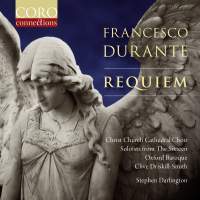Texte paru dans: / Appeared in: |
|
|
Evaluation: |
Outil de traduction ~ (Très approximatif) |
|
Reviewer: Rick Jones Francesco Durante was a product of the 17th-century Neapolitan conservatories as student and teacher. His Requiem in C minor dates from 1746 when he was 62 and had taught Pergolesi. The duet, which starts each of the first two movements, recalls his student’s famous Stabat mater in the soloists’ parallel thirds. The duet is brief and the chorus takes over, the bright-toned, unmistakably boyish trebles of Christ Church Oxford arriving alert and fresh at luceat eis.
None of the solos are long unlike the work itself, which lasts 50 minutes. Later composers would omit movements and might repeat the Dies irae; Durante sets all 11 from Introitus to the Offertorium, and repeats his Dies irae music to different words, the choir in stabbing crotchets alternating with string scales in unison and contrary motion. It is really a choral composition with the opportunity for a few leading voices to shine. Soprano I has the lion’s share and Alexandra Kidgell the straight pure consistent tone and precise intonation to do it justice. Brass suddenly appears in the Tuba mirum but is otherwise absent. The Mass sections, Sanctus to Agnus, are for choir without soloists, and sound as if borrowed from another work.
The disc ends with a Durante organ concerto which links him with his contemporary Handel, also studying in Naples. They probably met, though Handel was also part of the opera crowd. Durante stuck to church music but presents no more gloomy front than two jaunty allegros enclosing a calming meditation.
|
|
|
Support us financially by purchasing this disc from eiher one of these
suppliers.
|
|
|
|
|
|
Cliquez l'un ou l'autre
bouton pour découvrir bien d'autres critiques de CD |
|




